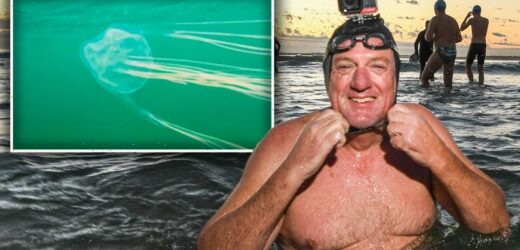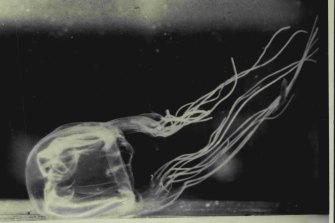Sightings off Cronulla of a jellyfish that shares structural features with northern Australia’s deadly box jellyfish have prompted an expert to raise concern about first aid practices for jellyfish stings outside the tropics.
“It’s a heck of a find,” said Dr Lisa-ann Gershwin, a Launceston biologist who has described more than 200 types of jellyfish. “Needless to say, that sucker doesn’t belong there.”
Scott Belcher, who filmed a strange jellyfish off Cronulla last week (inset), at Cronulla on Friday. Credit:Main photo: Peter Rae
Gershwin said the jellyfish was definitely not the northern box jellyfish (commonly known as the Australian box jellyfish), the “supercharged Ferrari of death” that reigns as the world’s most venomous animal. But until the jellyfish filmed in Cronulla is officially identified, she is holding “equal space” for the possibility the jellyfish is dangerous or harmless.
Ocean swimmer Scott Belcher saw the jellyfish about 800 metres from the shore twice last week. He circles Shark Island in Cronulla most mornings with the swimming group SIPS (Shark Island Psycho Swimmers).
Belcher thought it was a jimble, a species of southern box jellyfish that occasionally sparks panic when clusters are sighted in Sydney waters. Belcher said a jimble sting feels “like a cattle prod”, but they are not deadly.
“When I took a closer look I thought, ‘Nup, this is something meaner,’ ” he said of the jellyfish he filmed last week. “Jimbles and this thing are like chalk and cheese.”
A species of deadly box jellyfish, seen in a file picture.Credit:Fairfax Media
Jimbles have a single round tentacle that resembles a strand of spaghetti coming off each corner of its head, or bell.
The jellyfish at Cronulla, about 30 to 40 centimetres long, had multiple tentacles trailing off each corner of its palm-sized bell. And the shape of those tentacles concerned Gershwin.
“The dangerous species have flatter tentacles, like fettuccine,” she said, adding that they include the deadly tropical box jellyfish and the morbakka, which belongs to a group of tiny box jellyfish species known as irukandji that are sometimes found in northern NSW.
Although the jellyfish in Cronulla had quite flat tentacles, the creature also had “gelatinous knobs that look like marbles” within its body that are “very much related to non-dangerous species”.
Gershwin is working with the Australian Museum to identify the jellyfish, which could be new to science and is probably in the same class, Cubozoa, as jimbles, irukandji and the box jellyfish.
After the Cronulla sighting, Gershwin warned that pouring hot water on a jellyfish wound – a common treatment for bluebottle stings – can aggravate venomous stings.
“When someone is stung by a box jellyfish, only about 10 to 20 per cent of the stinging cells fire,” she said. “Fresh water triggers all the stinging cells that haven’t fired so the remaining 80 to 90 per cent of venom floods in.
“It’s the worst conceivable thing to do for a potentially dangerous species.”
The Australian Resuscitation Council recommends the application of vinegar in tropical areas because it freezes box jellyfish stinging cells that haven’t delivered venom. But vinegar could make bluebottle stings worse.
That’s why swimmers who are stung outside the tropics, if uncertain about which species they encountered, should wash sting sites thoroughly with seawater before applying hot or cold water.
“That will rinse away any remaining stinging cells remaining on the skin,” Gershwin said.
She speculated the floods could have attracted an open-water species closer to the coast due to recent record rain sweeping extra nutrients into the ocean. The specimen could also be a “supercharged” pygmy box jellyfish, a “tiny guy the size of your thumb” found on the Gold Coast that Gershwin identified and described in 2015.
The Morning Edition newsletter is our guide to the day’s most important and interesting stories, analysis and insights. Sign up here.
Most Viewed in National
From our partners
Source: Read Full Article




